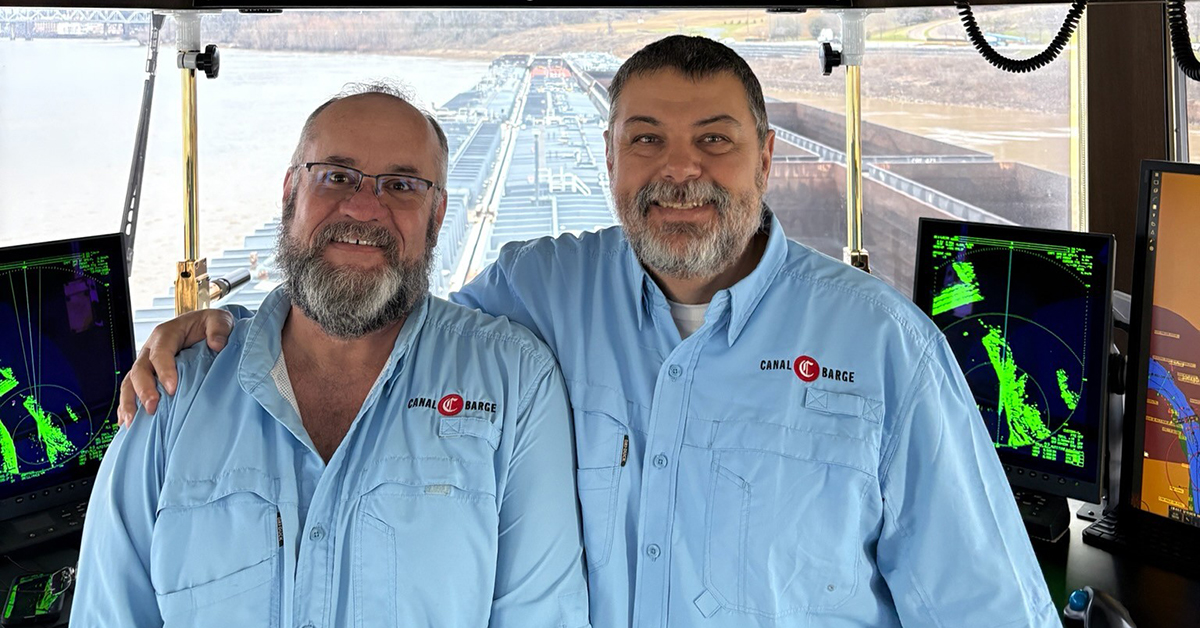Canal Barge has a unique distinction among long-lived towboating companies.
“In the 91 years we’ve been operating, Canal Barge has seldom if ever tied up a boat or laid anyone off,” Port Capt. Donnie Williams said.
That reputation of continuity and stability attracts and keeps people who want to build a life-long career on the rivers. One of these is Capt. John Hintson, who captains the mv. H. Merritt “Heavy” Lane Jr., built in 2020 at Conrad Shipyard in Amelia, La. A twin-screw, 157.3-foot-long, 6,000 hp. boat powered by Tier 4 EMD diesel engines, the Heavy Lane, as Hintson calls it, is Canal Barge’s flagship, named after former company executive and director Harry Merritt Lane Jr. The vessel has all the latest crew comforts and safety features. It normally operates with a crew of nine in a 28-days-on, 28-days-off schedule. It has beds to accommodate up to 13 people, can maintain a 10-knot running speed and push up to 30 barges in a tow.
Hintson has been with Canal Barge his entire 35-year-long career, starting out as a deckhand in 1990. “I had two and a half years of college and ran out of money,” he told The Waterways Journal. “My plan was just to make some money and go back, but I ended up staying on the rivers as I got married and life happened. I never looked back, stayed out here and made a career of it. Canal Barge was my Harvard degree on the rivers.”
Hintson didn’t aim at the wheelhouse right away.
“Back then, engineers and pilots made about the same money,” he said, but pilot pay has since pulled ahead. In the end, “I didn’t like painting that much,” Hintson joked. “I made it into the wheelhouse to get away from the painting.”
Marc Zoerner is Hintson’s regular pilot who relieves him in the wheelhouse. He has been with Canal Barge for four and a half years. He earned his own captain’s license in 1997 at age 22 after spending time in a steersman program. “I was turned loose in the wheelhouse in 1997 and got my first captain’s position in 2003,” he said.
Zoerner did a lot of “tripping” or temporary piloting at one time for various towing companies, including Kirby, Florida Marine, Blessey Marine, Ingram and “several smaller companies.” One advantage of tripping, Zoerner said, is that it familiarizes a pilot with many different types of boats, crews and river conditions. He hasn’t tripped in about 15 years, he adds, and is very happy at Canal.
Canal Barge likes to keep the same crews on the same boats, if possible. “Crew cohesion is very important,” Hintson said. “It’s definitely more of a family situation. When you work with the same guys all the time, you know how they will react and how they operate. It’s a big plus for safety, too.”
Labor recruitment and retention has long been a concern on the rivers, and the replacement cycle takes years of training. Canal Barge has some very experienced pilots and captains who keep working despite being over 70 years old.
“Every company I know of is short between five and 10 people in the wheelhouse,” Hintson said.
There are plenty of younger pilots and captains moving up at Canal Barge, he said. Hintson is grateful for the experience of the older pilots and captains and their willingness to pass their knowledge on.
Towing companies need to hire and train new deckhands as they progress up the ladder to tankerman, mate, pilot and captain. That’s part of Canal Barge’s training program, so that by the time captains get to the wheelhouse, they have experienced every job under their command. Hintson himself spent several years working as a tankerman.
The regular run of the Heavy Lane is between St. Louis and the Lower Illinois River. Both men prefer the Lower Mississippi River to the Illinois River. “There’s usually better depth on the Lower Miss than the Illinois, which has no real current to help you along” Hintson said.
“The Lower Miss only gets crowded below the Baton Rouge bridge,” Zoerner said. Even so, the river and river bottom are constantly changing, both men said. The Heavy Lane makes occasional runs up the Ohio River as well.
Canal Barge’s tows “carry everything from rocks to rockets,” Zoerner said, including petroleum products, chemicals, food oils, pet coke, salt, aggregate and grains, as well as flat deck barges carrying modular components for plants, refineries and liquid natural gas facilities under construction.
Asked what his most memorable experiences were, Hintson mentioned the eight times he helped push LeTourneau’s massive oil rigs from their fabrication facility in Vicksburg, Miss., out into the Gulf. The assembled rigs would be pushed by four towboats faced up to them, with a radio lookout on the helipad of the rig helping to guide the boats.
Canal Barge has developed such a niche in specialty cargo moves that it is a preferred towing provider for the National Aeronautics and Space Administration (NASA) for moving its space exploration equipment by water in NASA’s barges, which are built to transit from inland ports to the launch site on the east coast of Florida.
Both men agree that safety training has improved dramatically since they started out. As part of continuously improving its safety culture, Canal Barge has initiated a monthly “TSMS challenge,” in which crews answer questions about the company’s Towing Safety Management System manual, with mariners who answer correctly winning prizes from the company store.
————
Featured photo caption: Pilot Mark Zoerner (left) and Capt. John Hintson (right) in the wheelhouse of the mv. H. Merritt “Heavy” Lane Jr. (Photo courtesy of Canal Barge.)




